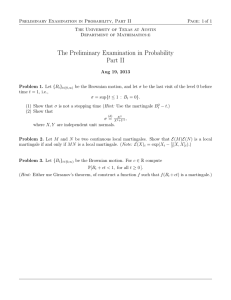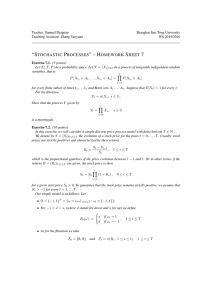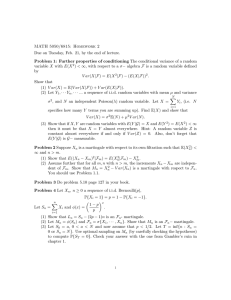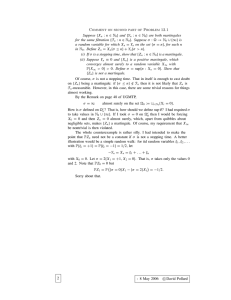241B Lecture Stochastic Processes Martingales Let Xt be an
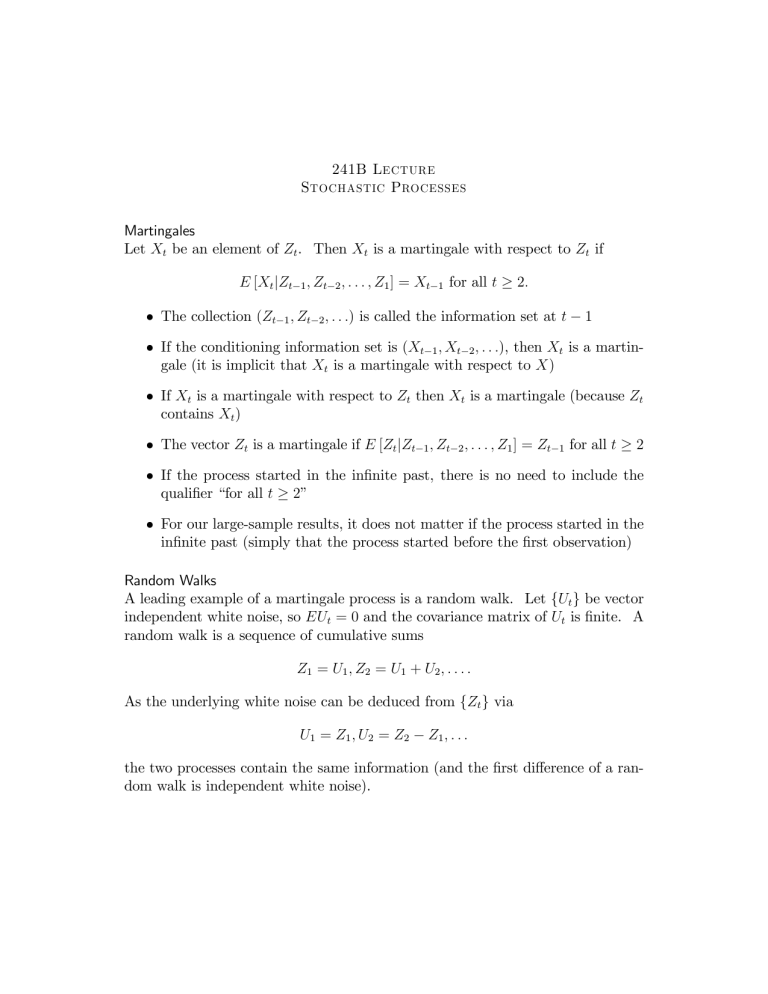
241B Lecture
Stochastic Processes
Martingales
Let X t be an element of Z t
. Then X t is a martingale with respect to Z t if
E [ X t j Z t 1
; Z t 2
; : : : ; Z
1
] = X t 1 for all t 2 :
The collection ( Z t 1
; Z t 2
; : : : ) is called the information set at t 1
If the conditioning information set is ( X t 1
; X t 2
; : : : ) , then X t gale (it is implicit that X t is a martingale with respect to X ) is a martin-
If X t is a martingale with respect to Z t contains X t
) then X t is a martingale (because Z t
The vector Z t is a martingale if E [ Z t j Z t 1
; Z t 2
; : : : ; Z
1
] = Z t 1 for all t 2
If the process started in the in…nite past, there is no need to include the quali…er “for all t 2 ”
For our large-sample results, it does not matter if the process started in the in…nite past (simply that the process started before the …rst observation)
Random Walks
A leading example of a martingale process is a random walk. Let f U t g be vector independent white noise, so EU t
= 0 and the covariance matrix of U t is …nite. A random walk is a sequence of cumulative sums
Z
1
= U
1
; Z
2
= U
1
+ U
2
; : : : :
As the underlying white noise can be deduced from f Z t g via
U
1
= Z
1
; U
2
= Z
2
Z
1
; : : : the two processes contain the same information (and the …rst di¤erence of a random walk is independent white noise).
That a random walk is a martingale is shown as
E [ Z t j Z t 1
; Z t 2
; : : : ; Z
1
] = E [ Z t j U t 1
; U t 2
; : : : ; U
1
]
= E [ U
1
+ U t j U t 1
; U t 2
; : : : ; U
1
]
= U
1
+ + U t 1 because E [ U t j U t 1
; U t 2
; : : : ; U
1
] = 0
= Z t 1
:
Martingale Di¤erence Sequences
A vector process f U t g is called a martingale di¤erence sequence (m.d.s.) if
E [ U t j U t 1
; U t 2
; : : : ; U
1
] = 0 for t 2 :
The process is so called because the cumulative sum formed from an m.d.s. is a martingale. Conversely, if f Z t g is a martingale, the …rst di¤erence of Z t forms a martingale di¤erence sequence.
A martingale di¤erence sequence has no serial correlation.
E U t
U
0 t j
= E E ( U t j U t j
) U
0 t j
:
Note
E ( U t j U t j
) = E ( E ( U t j U t 1
; : : : ; U t j
; : : : U
1
) j U t j
) = 0 :
ARCH Processes
An important class of martingale di¤erence sequences are ARCH sequences, which are commonly used to model …nancial asset prices.
Introduced by Engle, an
ARCH(1) process is q
U t
= + U 2 t 1
V t
; where f V t g is i.i.d. with mean 0 and variance 1. If U
1 is the initial value of the process, then U t is a function of U
1 and ( V
2
; : : : ; V t
) . Therefore V t is independent of ( U
1
; : : : ; U t 1
) .
To show that an ARCH sequence is an m.d.s., q
E [ U t j U t 1
; U t 2
; : : : ; U
1
] =
=
E q
+
+ U 2 t 1
U 2 t 1
E [ V
V t j U t 1
; U t 2
; : : : ; U t j U t 1
; U t 2
; : : : ; U
1
]
1
= 0 because V t is independent of ( U
1
; : : : ; U t 1
) :
An ARCH process is conditionally heteroskedastic
E U t
2 j U t 1
; U t 2
; : : : ; U
1
= + U
2 t 1
:
If j j < 1 the process is strictly stationary and ergodic (provided the process started in the in…nite past or that U
1 is drawn from an appropriate distribution).
If the process is stationary, the unconditional variance is
EU t
2
= + EU
2 t 1
:
Because EU 2 t
= EU 2 t 1 under stationarity,
EU t
2
=
1
:
Formulations of Serial Uncorrelatedness
For zero mean, covariance stationary processes, we have three di¤erent strengths of lack of serial correlation. From strongest to weakest:
1.
f Z t g is independent white noise
2.
f Z t g is a stationary m.d.s. with …nite variance
3.
f Z t g is white noise.
Level 2 allows processes that are dependent, although serially uncorrelated.
For example, the ARCH process in which the conditional variance of Z t depends on Z t 1
. Level 3 allows processes that have conditional means that are not zero, although the unconditional mean remains zero. Consider the example process in which the cosine function is used
Z t
= cos ( tw ) ( t = 1 ; 2 ; : : : ) :
We have
E ( Z
2 j Z
1
) = E (cos (2 w ) j cos ( w )) = 2 cos ( w )
2
:
The CLT for Ergodic Stationary Martingale Di¤erence Sequences
The following CLT extends the Lindberg-Levy CLT to stationary and ergodic m.d.s.
Ergodic Stationary Martingale Di¤erence CLT: Let f U t g be a vector martingale di¤erence sequence that is stationary and ergodic with n
E ( U t
U =
1 n t =1
U t
.
Then
U 0 t
) = and p nU = p
1 n t =1
U t
!
d
N (0 ; ) :
This CLT is applicable not just to i.i.d. sequences, but also to stationary martingale di¤erence sequences, such as ARCH processes (although we have not yet allowed for serially correlated processes).
1. Because f U t g is an m.d.s. with mean zero, there is no need to subtract a mean from U .
2. Because f U t g is stationary, the covariance matrix does not depend on t . It is implicit that the moments exist and are …nite.
